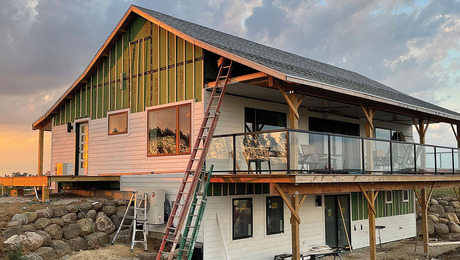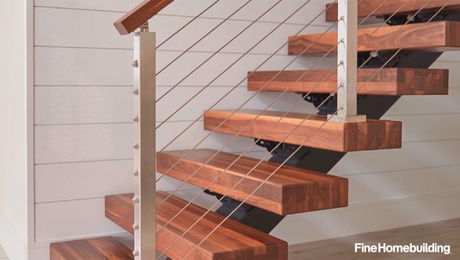Hi all,
I’m in the design phase of adding a mezzanine to a condo unit. The unit is an old mill building, and has 15 foot high floor to ceiling clearance. I’m trying to add a mezzanine/loft space that’s roughly 12′ x 16′ but I’d like to do it with as thin a floor as possible so I can maximize the hieghts above and below the mezzanine.
I was hoping for the standard 30-40 psf loading, I guess 10 dead load (prob. overkill). The entire mezzanine would sit on 2×4 stud walls on all 4 sides. All the walls are interior walls, the unit is basically exterior brickwork on one side, I was figuring on framing out from it. The other 3 walls would just be 2×4 framed.
Would short steel I-beams be goofy? – or maybe 2×6 on 12″ spacing be the thinnest I could expect?
















Replies
12' - 2X4 with 3/4" or thicker structural plywood under the joist, 16" or 12" o.c.. 1/2" plwood flooring on top.
Install the the first sheet of plywood in the center of the floor under the joist (you will need a lot of help, one sheet is too heavy to hold up there). Use liquid nails if you can (kinda hard to glue under the joist). Before nailing or screwing, jack up the floor a 1/2" (from underneath and make sure the joist are fully anchored). The plywood has to be staggered and run perpendicular to the joist.
What you will end up with is what I call a "Prestressed wood truss floor"
Disclaimer: I am not an Engineer nor am I a Carpenter.
The strongest possible floor diaphram of any thickness or technique is to add a second stress skin underneath.
Use perimeter blocks at the edges of all pieces of the skin.
You want the individual skins (1/2" ACX ply, for instance) to run parallel to the joists, so at the 8' line add a row of 2x4 blocks 4" face flush with the bottom of the joists. Glue and nail/screw the edges to these blocks.
The primary concern of the bottom stress skin is tensional strength parallel to the joists. You could steel band each joist (wrapped around edge-wise) and make super strong joists. Anything that increases the tensional strength and stretch resistance of the bottom of the joists.
Anything that increases the compressional strength of the tops of the joists will also help. 1" sheathing vice 3/4", for instance.
Anything that couples adjacent joists together will stiffen the floor, usually, but not nescessarily, making it stronger. Place cross blocking closer together.
You will have to get a special design like this enineered to get it past the AHJ.
I once built an 8' x 12' 2x4 porch deck with the 2x4s spanning 12' 'cuz I had 4' access doors on the 12' side. Joists @ 12"OC. Blocking @ 12" OC. 2 layers ACX, A sides on top and bottom of layers. All joints in sheathing staggered. 1/2" ACX on bottom of joists, A side down.
I could jump my 220lbs off a 4' ladder and barely flex the floor. That puppy was rigid.
The roofed, 1/2 walled, screened, porch was designed to be picked up and moved with a forklift!
SamT
Edited 5/6/2004 4:50 pm ET by SamT
Edited 5/6/2004 4:57 pm ET by SamT
Previous suggestions are good, though complicated.
Here's a couple of others:
1) 2x4's sandwitched glu-lam fasion can span 12' and create a "finished" floor and ceiling at the same time - only 3 1/2" thick.
2) an exposed beam ceiling with something like 2x6 T&G over 6x6 beams will give you a floor that's 7" thick over 15% of the area (36" oc) and 1 1/2" thick over 85% of the area. I couldn't say what the deflection might be, but you could park a truck on it and it wouldn't fail.
3) Depending on the aestetics of the room, sightlines and such, 7' ceilings in a small area are not that unusual or uncomfortable. Then you have 12" to play with and no worries. I'm not sure how much effort and $ I would invest to gain 2-3" or so in ceiling height.
Good luck (I would choose #2)
i have seen prestress concrete slab as thin as three inches with no beams under
Thanks for the responses! That was really quick. I love this place. Love it.
In hearing the word "prestressed" I started thinking about maybe a Stress Skin Panel for the floor. I found one company (too far away to be cost effective) that had a 6" stresskin panel with a 63psf load rating at 1/360! The price is right, but the shipping from Idaho to Boston would be the killer.
I like the timber idea of the 6x6, I'm having trouble finding a timber span chart to check it out.
Anyone know where to get a SIP in the Boston area? Or a timber span table?
Thanks
Jason in Boston
(span table URL toward bottom of this list...)
Probably not at all what you are interested in, but Hollowcore panels easily could span the width that you mentioned. Don't know the price but plan on investigating for a project I am designing. Last week I ran across a span chart for one style of poured in place concrete floor over corregated metal deck, but can't seem to locate it at the moment. Anyway, some items for your leisure perusal...
http://articles.findarticles.com/p/articles/mi_m0NSX/is_11_47/ai_94639548
Hollowcore panels - 6 in depth gives 22 ft span, 8" gives 29 ft.
http://www.mapaprecast.org/newsletters/03-summer.pdf
Lite deck: http://www.insulatingconcretehomes.com/litedeck.html
http://www.concretecentre.com/main.asp?page=133
Maximum Span Calculator for Joists and Rafters:
http://www.awc.org/calculators/span/calc/timbercalcstyle.asp
vermiculite cement: http://www.schundler.com/const.htm
Mother Earth article:
http://www.motherearthnews.com/menarch/archive/issues/085/085-150-01.htm
Edited 5/6/2004 7:21 pm ET by CaseyR
As I was reading along through this thread I kept thinking, "come-on - somebody is going to mention SIPs any minute now." Good call.
Here is a location map for my preferred panel manufacturer. http://www.r-control.com/location/default.asp Nothing in Boston but two plants that might be close enough for reasonable shipping.
Here is a link to a few companies in your area that might be able to help as well.
http://www.sipweb.com/directory/Search_result.asp?Product_Type_ID=2&companytype=ALL&State=MA&CompanyName=&Submit1=Start+SearchKevin Halliburton
"Do you see a man skilled in his work? He will serve before kings; he will not serve before obscure men." - Solomon
I like Nannygee's #1. I've seen walkways made with 2X4's on edge with a space in between for drainage. Depends on the look you are going for, really. Or just 2X4's - 8" on center.
Engineered lumber, like Microlam beams can work, too. They can be ripped to thinner depths.
You'd certainly have to engineer this. Going by feel or rules of thumb in this case can be a really bad idea.
You also have to provide shear bracing for the walls. A platform sitting on four basically free standing walls can just rack, twist, and collapse. Tie the one wall off to the brick. But also you'll need solid prevention for the other walls. I'd recommend plywood sheathing (probably doesn't have to be too thick) securely nailed to one side of all three walls not attached to the brick.
You may want a structural engineer for this. You'll get the lowest cost assembly that is sure to be safe by designing it according to the numbers.
Jason,
The stressed skin panels seem to be your best bet. Sort of like a hollow core door -- very stiff and lightweight -- a good use of materials.
However, if this were a contest, my entry would be trench plate. That is the 1" thick steel plate contractors pit over trenches in roadways for temporary purposes while they figure out what to do next. Traffic can drive over these, even trucks.
It might be too heavy for 2 X 4 framing tho. You may want to opt for 2 X 6 but I am not a train driver.
~Peter
It has been a while since I toured industrial facilities, but it seems to me that a lot of manufacturing facilities had decks or mezzanines about the size you are contemplating. IIRC, many were welded up of diamond plate steel with framing from 3" channel iron and something like 4" steel pipes at corners to hold it all up. Plenty strong but probably more costly than using wood - particularly with the rising price of steel.
if you look back over some of my old questions/posts... i'm doing about what you are doing in an old mississippi river front warehouse... i have 10 lofts where i needed all the headroom i could get I'm getting 20ft out of 3.5" gluelams (3.5" x 12") mine are only supported on 3' angle iron bolted to a brick wall on one end and a 6x8 steel beam @ 16ft leave'n a 4 cantilever... but my engineer said they would span the 20... i just haveen to have the existing posts at 16ft... and yes they are being left exposed top & botton wood floor/ wood ceiling....
glue lams are made with a top & bottom (arch built in) you can T & G em or groove & spline em... in your situation they should span with no supports other than the walls you describe... and pretty cheap if figure what ur get'n ( floor & ceiling and no frame) and how fast they go up....
pony
Mezzanine floor structures which are built to have offices constructed on them have additional requirements to consider when compared to conventional “storage” ( spam link removed ) This includes resistance to flexing and vibration, noise and temperature insulation, minimizing of columns, dust sealing, aesthetics, ease of attaching lights, ceilings, providing electrical, plumbing services through the structure etc.
Thin floor system
You have gotten a lot of information, but when it's all said and done, you need to get an engineer involved to cover your arss. The design and construction of stress skin floor panels is not as simple as just nailing some lunber and plywood together. It is an engineered lumber product.
You might want to check with the American Plywood Assoc. It's been a while since I have built any stress skin panels, but they have a lot of info. on the subject.
Is this a true mezzanine (open to the floor below) or just a second story? Is this considered residential or commercial construction? The the design loading requirements may differ.
(Added thought). If open to the floor below and it would reduce the span, you could make/consider the required railing/wall as a beam to hang your floor framing on.
Oops, you're replying to a 10-year-old thread that was revived by a spammer.
Thanks Dan,
Now you know why the name "Oops"
Hi Jason,
I am working on a similar project (15'4" ceilings) and was looking into the same thing. What solution did you go with? What would you recommend based on your research and experience?
I like the timber idea of the 6x6, I'm having trouble finding a timber span chart to check it out.